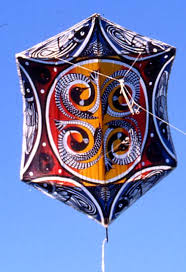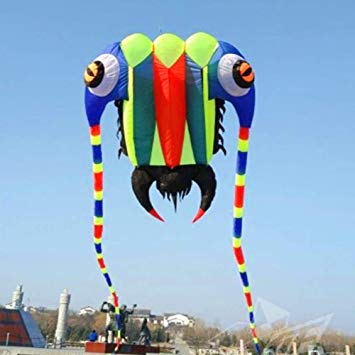Kite flying
in the country Ajaccio ©®
Single-line
kites
The basic principle of this type of kite is that it has only one point
of restraint on the ground, for the rest, its shape, its style of
flight, its dimensions, are at the option of imagination and creation
of kite flyers.
We
can still classify single-line kites according to their designs:
Flat
kites whose simplest example is the delta;
The
dihedral kites with the famous rhombus with which all the children
played on the beach;
Maneuverable,
fast-moving, fast-action kites armed with cutting wire to challenge
each other in duels;
The cellular kites at the
origin of modern aviation with the Cody.
Wings with caissons
We meet kites without
armature.
Invented in the sixties, the parafoil consists of two planes canvas one
above the other, joined by partitions that give its profile to the wing.
These
partitions delimit caissons, which are open at the front, and inflate
with the wind pressure and the relative speed of the kite, giving the
wing its rigidity.
It
is the ancestor of modern paragliders and parachutes.
These
wings are most often used for kites without frame.
Invented
in the sixties, the parafoil consists of two planes canvas one above
the other, joined by partitions that give its profile to the wing.
These wings are most often used
for land traction.
Plan
The simplest kites
consist of a
simple canvas plan, stretched over a cross of chopsticks. We can cite
the classic kite, the Eddy (the previous one, slightly modified to fly
without tail), or the hexagonal Japanese Rokkaku, used for fighting.
Then
there are crate kites, composed of a variable number of cells, with
planes of load-bearing canvases, vertical, and other horizontal
stabilizers. (Cody, Saconney, Weather, etc).
A
separate mention for the Sled (sledge), which can be made in minutes by
a child with simple materials, like two reeds glued to the adhesive on
a properly cut plastic bag.
Stunt kites
In the case of the
two-wire kite,
there is the possibility that the pilot has to turn his device
clockwise (traction on the right wire) or anti-clockwise (traction on
the left wire).
The absence of differential
traction makes it possible to make the machine go in a straight line.
In the case of the
four-line kite,
the main work is done at the level of the inclination of the wrists: by
tilting the left wrist down, we put the left wing negative impact,
which makes it back, and therefore causes rotation on the spot in a
counter-clockwise direction.
By
putting both hands in negative impact, the kite retreats.
By
finely tuning the angle setting, the kite can hover in any position,
anywhere in the flight window.
The
flight of the four-line kite makes one think, by its flexibility, that
of the helicopter.
It
is the only machine to allow movement in any direction (forward,
backward, skew) and to offer the ability to be stopped with a
surprising clarity, even a few inches from the ground.
The first commercially piloted
4-wire kite was Revolution kite's rev1.
The acrobatic kite (freestyle)
This discipline is a
physically
demanding discipline, with most figures requiring a certain amount of
fanfare. It is not uncommon to be forced to run and / or have very
quick and coordinated actions.
The precision
PrecisionThis
discipline consists of
the realization of codified figures. It is practiced alone or with
others. The main criteria of notation are the precision of the
realization of the figure in the "window" as well as the sharpness of
the whole.
Ballet
Ballet is a discipline
similar to
ballet in figure skating which can be practiced either individually or
in pairs or teams (at least three members). Ballet consists of the
interpretation of a piece of music according to a choreography that can
incorporate all types of figures. Without music, this is not a ballet.
The indoor kite
Practiced indoors with
kites usually
very light, (now or sul) this discipline uses the relative wind created
by the movement of the pilot to keep the kite flying.
the
absence of wind allows the kite to make 360 ° horizontal and
180 ° vertical passing over the pilot's head.
Aerial photography
Aerial photography by kite was initiated by the French photographer
Arthur Batut in 1888.
The
kite can indeed serve as an economical way to make aerial photographs.
The
Rokkaku ("hexagon" in Japanese) is a kite particularly suited to this
discipline, because it is both very stable and very good carrier.
Shapes
They are all raised thanks to another kite called "carrier".
The wind enters the opening (s) which shapes the structure











